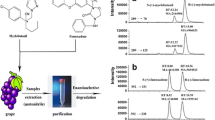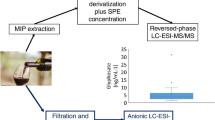Abstract
Enantioselective monitoring of chiral fungicide mandipropamid enantiomers were carried out in grapes and wine-making process. The enantiomers of mandipropamid were separated on a Lux Cellulose-2 column and determined by ultra-high-performance liquid chromatography coupled with tandem mass spectrometry (UHPLC–MS/MS). The processing procedure included washing, fermentation, and clarification. Significant enantioselectivity was observed in grape under field conditions and during wine-making processing. The half-lives of R-mandipropamid and S-mandipropamid were 5.63 days and 7.79 days under field conditions 43.3 h and 69.3 h during wine-making processing, respectively. The EF values ranged from 0.498 to 0.283 in grape under field conditions, and the EF values were from 0.458 (0 h) to 0.362 (312 h) during the whole fermentation process. The results indicated that R-mandipropamid degraded faster than S-mandipropamid in grape under field conditions and during the fermentation process. The processing factors (PFs) were less than 1 for each procedure, and the PF ranged from 0.005 to 0.025 in the overall process, which indicated that the wine-making process can reduce mandipropamid residue in grape wine. The results of this study could help facilitate more accurate risk assessments of mandipropamid in table grapes and during wine-making process.



Similar content being viewed by others
References
Amvrazi EG, Albanis TA (2008) Multiclass pesticide determination in olives and their processing factors in olive oil: comparison of different olive oil extraction systems. J Agric Food Chem 56(14):5700–5709
Angioni A, Dedola F, Garau VL, Schirra M, Caboni P (2011) Fate of iprovalicarb, indoxacarb, and boscalid residues in grapes and wine by GC-ITMS analysis. J Agric Food Chem 59(12):6806–6812
Cabras P, Angioni A (2000) Pesticide residues in grapes, wine, and their processing products. J Agric Food Chem 48(4):967–973
Choung MG, Ahn KG, Kim GP, Hwang YS, Kwon CH, Kang IK, Lee YD (2016) Dissipation pattern of a fungicide mandipropamid in Korean cabbage at different harvest times under greenhouse conditions. Korean J Hortic Sci Technol 34:644–654
Cooper J, Dobson H (2007) The benefits of pesticides to mankind and the environment. Crop Prot 26(9):1337–1348
Fantke P, Juraske R (2013) Variability of pesticide dissipation half-lives in plants. Environ Sci Technol 47(8):3548–3562
FAO/WHO (2006) Updating the principles and methods of risk assessment: MRLs forpesticides and veterinary drugs. FAO, Rome
Garrison A (2006) Probing the enantioselectivity of chiral pesticides. Environ Sci Technol 40(1):16–23
Gonzalez-Rodriguez R, Rial-Otero R, Cancho-Grande B, Gonzalez-Barreiro C, Simal-Gandara J (2011) A review on the fate of pesticides during the processes within the food-production chain. Crit Rev Food Sci Nutr 51(2):99–114
Han Y, Xu J, Dong F, Li W, Liu X, Li Y, Kong Z, Zhu Y, Liu N, Zheng Y (2013) The fate of spirotetramat and its metabolite spirotetramat-enol in apple samples during apple cider processing. Food Control 34(2):283–290
Han Y, Dong F, Xu J, Liu X, Li Y, Kong Z, Liang X, Liu N, Zheng Y (2014) Residue change of pyridaben in apple samples during apple cider processing. Food Control 37(1):240–244
Hercegova A, Domotorova M, Hrouzkova S, Matisova E (2007) Study on pesticide residues in apples, apple-based baby food, and their behaviour during processing using fast GCeMS multiresidue analysis. Int J Environ Anal Chem 87(13–14):957–969
Hwang ES, Cash J, Zabik M (2002) Degradation of mancozeb and ethylenethiourea in apples due to postharvest treatments and processing. J Food Sci 67(9):3295–3300
Kaushik G, Satya S, Naik SN (2009) Food processing a tool to pesticide residue dissipation – a review. Food Res Int 42(1):26–40
Kong Z, Dong F, Xu J, Liu X, Zhang C, Li J, Li Y, Chen X, Shan W, Zheng Y (2012) Determination of difenoconazole residue in tomato during home canning by UPLC-MS/MS. Food Control 23(2):542–546
Krol WJ, Arsenault TL, Pylypiw HM Jr, Mattina MJI (2000) Reduction of pesticide residues on produce by rinsing. J Agric Food Chem 48(10):4666–4670
Lamberth C, Jeanguenat A, Cederbaum F, De Mesmaeker A, Zeller M, Kempf HJ et al (2008) Multicomponent reactions in fungicide research: the discovery of mandipropamid. Bioorg Med Chem 16(3):1531–1545
Li Y, Dong F, Liu X, Xu J, Chen X, Han Y, Cheng Y, Jian Q, Zheng Y (2013) Enantioselective separation and transformation of metalaxyl and its major metabolite metalaxyl acid in tomato and cucumber. Food Chem 141(1):10–17
Li Y, Dong F, Liu X, Xu J, Han Y, Zheng Y (2014) Chiral fungicide triadimefon and triadimenol: stereoselective transformation in greenhouse crops and soil, and toxicity to Daphnia magna. J Hazard Mater 265:115–123
Lu Y, Diao J, Xu G, Zhang Y, Xu P, Wang P et al (2011) Stereoselective degradation of diclofop-methyl during alcohol fermentation process. Chirality 23(5):424–428
Malhat FM, Mahmoud HA (2012) Dissipation and residues of mandipropamid in grape using QuEChERS methodology and HPLC-DAD. ISRN Anal Chem 2012:1–5
Noelia B, Laura C, Raquel R, Beatriz C, Jesus S (2018) Fungicide residues affect the sensory properties and flavonoid composition of red wine. J Food Compos Anal 66:185–192
Noelia B, Raquel R, Miguel AC, Jose O, Jesus S (2019) Dissipation of three fungicides and their effects on anthocyanins and color of monastrell red wines. Int J Mol Sci 20(6):1447
OECD (2007) Guidance document on pesticide residue analytical methods (pp. 18–28). ENV/JM/MONO(2007), 17
OECD (2008) OECD guideline for the testing of chemicals. Magnitude of the pesticide residues in processed commodities. NO.508
Pan X, Dong F, Xu J, Liu X, Chen Z, Zheng Y (2016) Stereoselective analysis of novel chiral fungicide pyrisoxazole in cucumber, tomato and soil under different application methods with supercritical fluid chromatography/tandem mass spectrometry. J Hazard Mater 311:115–124
Pan X, Dong F, Liu N, Cheng Y, Xu J, Liu X, Wu X, Chen Z, Zheng Y (2018) The fate and enantioselective behavior of zoxamide during wine-making process. Food Chem 248:14–20
Raquel N, Tania F, Thais S, Carmen G, Beatriz C, Diego-Augusto C, Maria G, Marai-Teresa M, Jesus S, Jesus S (2016) Dissipation of fungicide residues during winemaking and their effects on fermentation and the volatile composition of wines. J Agric Food Chem 64(6):1344–1354
Rasmusssen R, Poulsen ME, Hansen H (2003) Distribution of multiple pesticide residues in apple segments after home processing. Food Addit Contam 20(11):1044–1063
Sekhon B (2009) Chiral pesticides. J Pest Sci 34(1):1–12
Thais S, Maria F, Carmen G, Jesus S, Betariz C, Raquel R (2019) Impact of mepanipyrim and tetraconazole in Mencía wines on the biosynthesis of volatile compounds during the winemaking process. Food Chem 300:125223
Ulrich EM, Morrison CN, Goldsmith MR, Foreman WT (2012) Chiral pesticides: identification, description, and environmental implications. Rev Environ Contam Toxicol 217:1–74
Xu C, Wang JJ, Liu WP, Sheng GD, Tu YJ, Ma Y (2008) Separation and aquatic toxicity of enantiomers of the pyrethroid insecticide lambda-cyhalothrin. Environ Toxicol Chem 27(1):174–181
Ye J, Zhao M, Liu J, Liu W (2010) Enantioselectivity in environmental risk assessment of modern chiral pesticides. Environ Pollut 158(7):2371–2383
Zhang H, Wang XY, Wang XQ, Qian MR, Xu MF, Xu H et al (2014) Enantioselective determination of carboxyl acid amide fungicide mandipropamid in vegetables and fruits by chiral LC coupled with MS/MS. J Sep Sci 37(3):211–218
Zhang Q, Hua XD, Shi HY, Liu JS, Tian MM, Wang MH (2015) Enantioselective bioactivity, acute toxicity and dissipation in vegetables of the chiral triazole fungicide flutriafol. J Hazard Mater 284(284):65–72
Funding
This work was supported by Agricultural Science and Technology Innovation Program of CAAS (CAAS- ZDRW202011) and the National Program for Quality and Safety Risk Assessment of Agricultural Products of China (GJFP2019011).
Author information
Authors and Affiliations
Corresponding author
Additional information
Responsible Editor: Philippe Garrigues
Publisher’s note
Springer Nature remains neutral with regard to jurisdictional claims in published maps and institutional affiliations.
Rights and permissions
About this article
Cite this article
Xu, G., Jia, X., Zhang, H. et al. Enantioselective fate of mandipropamid in grape and during processing of grape wine. Environ Sci Pollut Res 27, 40148–40155 (2020). https://doi.org/10.1007/s11356-020-10061-2
Received:
Accepted:
Published:
Issue Date:
DOI: https://doi.org/10.1007/s11356-020-10061-2




